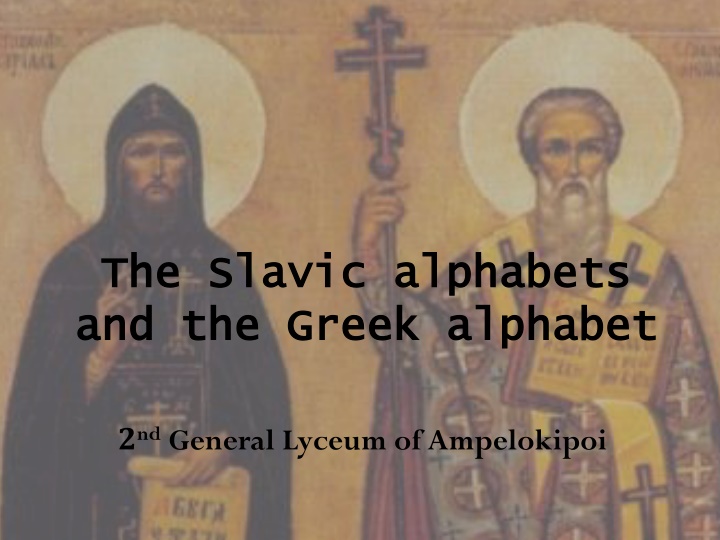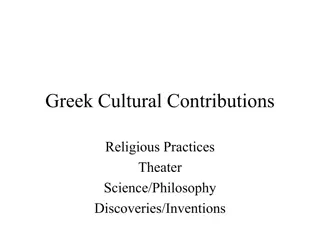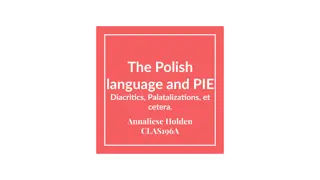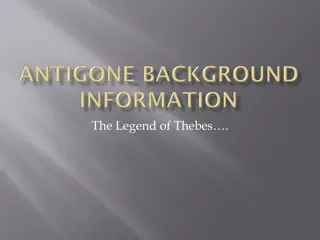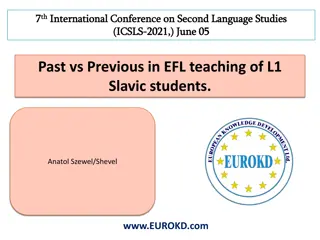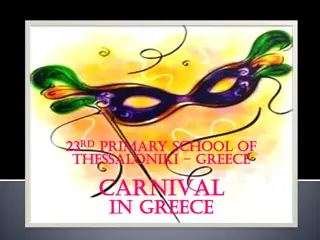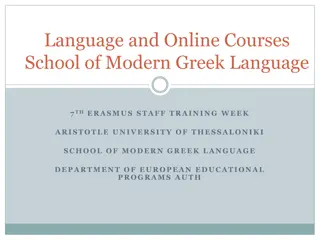The Slavic alphabets and the Greek alphabet
Byzantium played a crucial role in shaping the Slavic alphabets through the creation of the Glagolitic and Cyrillic alphabets, fostering cultural ties between the two regions. This historical connection led to the translation of religious texts and the spread of literacy in the Slavic world.
Download Presentation

Please find below an Image/Link to download the presentation.
The content on the website is provided AS IS for your information and personal use only. It may not be sold, licensed, or shared on other websites without obtaining consent from the author.If you encounter any issues during the download, it is possible that the publisher has removed the file from their server.
You are allowed to download the files provided on this website for personal or commercial use, subject to the condition that they are used lawfully. All files are the property of their respective owners.
The content on the website is provided AS IS for your information and personal use only. It may not be sold, licensed, or shared on other websites without obtaining consent from the author.
E N D
Presentation Transcript
The Slavic alphabets The Slavic alphabets and the Greek alphabet and the Greek alphabet 2ndGeneral Lyceum of Ampelokipoi
Contents Contents The gift of Byzantium to Slavic The gift of Byzantium to Slavic culture culture The Glagolitic alphabet The Glagolitic alphabet The Cyrillic alphabet The Cyrillic alphabet Bibliography Bibliography
The Gift of Byzantium to The Gift of Byzantium to Slavic Culture Slavic Culture 9 9th of of th In In ruler ruler establish establish close with with Byzantium, Byzantium, of of gaining gaining Moravian Moravian Church an an archbishopric archbishopric. . Thus, Thus, in in 863 Michael Michael sent sent the the Methodius Methodius alphabet alphabet. . the the century, century, Moravia Moravia, , close diplomatic diplomatic relations with with the the independence independence Church and and elevating elevating it Rastislav Rastislav, , sought sought the the to to relations main main for for it to goal goal the the to 863, , the III III the Byzantine Byzantine Emperor and and the the Caesar Caesar brothers brothers to to create create Emperor Bardas Bardas Cyril Cyril a a and and Slavic Slavic
The The delivering delivering Alphabet Alphabet. . the the creator creator his his teacher, teacher, Patriarch Saints Saints Cyril Cyril the the is is was was Patriarch Fotios and and Methodius Methodius Glagolitic Glagolitic verified verified himself himself Fotios. . It It not not Cyril Cyril if if or or
The Glagolitic alphabet The Glagolitic alphabet The The alphabet alphabet Slovenian Slovenian which which means The The writing writing distinctive distinctive closely closely alphabet alphabet of Scientists Scientists that that Glagolitic Glagolitic origins origins Hebrew Hebrew- -Samaritan, Samaritan, and and other other scripts scripts. . Glagolitic Glagolitic from from glagol glagol , speech . . morphology morphology system system and and resemble resemble of that that era era. . have have some some letters letters alphabet alphabet in in the the term term comes comes word word the the , means speech of of the the is is not not any any does does concluded concluded in in the the have have Georgian, Georgian, Syriac Syriac, , alphabets alphabets and and
The first text that was translated was the first chapter of the Gospel of John, In the the beginning beginning there there was was the In the earliest Slavic the Glagolitic alphabet, included: the Psalter, the Gospels, the Evangelistaries, and ecclesiastical texts of lesser importance. The Morning Service (Orthros), the Divine Liturgy, the Hours, Supplicatory Canon (Apodeipnon), Euchologion were translated and taught. In the Word books Word written there Euchologion, in are the Tetraevangelion, some other the smaller Vespers, the the and
The Cyrillic alphabet The Cyrillic alphabet The The was was created created in century century It It consisted consisted letters letters, , derived derived Greek Greek the the remaining remaining 14 specifically specifically to to phonological phonological unique unique language language. . Cyrillic Cyrillic alphabet alphabet in the the 9 9th Bulgaria Bulgaria. . of of with with from from script script, , 14 were th in in 38 38 24 24 the the while while were created created represent represent values values the the Slavic Slavic to to
There are There are three prevailing opinions three prevailing opinions regarding the the origin of the Cyrillic alphabet origin of the Cyrillic alphabet. . regarding Some scholars argue that Cyril created the Some scholars argue that Cyril created the script to convey the lofty meanings of the script to convey the lofty meanings of the Holy Scriptures in the Slavic language. Holy Scriptures in the Slavic language. ii. Other scholars connect the creation of this Other scholars connect the creation of this script with Constantine, the bishop of script with Constantine, the bishop of Preslav Preslav, who wished to preserve the memory of , who wished to preserve the memory of the creator of the first alphabet among the the creator of the first alphabet among the Slavs. Slavs. iii. iii.Some members of the scientific community Some members of the scientific community argue that the Cyrillic alphabet was invented argue that the Cyrillic alphabet was invented by Clement, a disciple of the two saints by Clement, a disciple of the two saints Cyril and Methodius. Cyril and Methodius. i. i. ii.
Today the Cyrillic alphabet is used by Today the Cyrillic alphabet is used by the people who were Christianized by the people who were Christianized by the Byzantine Church, such as the the Byzantine Church, such as the Bulgarians Bulgarians, , Russians Russians, Belarusians Belarusians, and , and Ukrainians Ukrainians. Over time, it has undergone it has undergone changes changes and acquired distinct characteristics in each distinct characteristics in each country. Specifically, in Bulgaria in country. Specifically, in Bulgaria in the 14 the 14th century, in Russia in 1708, and during the 1920s in the Soviet Union, during the 1920s in the Soviet Union, where it underwent modifications due to where it underwent modifications due to linguistic changes and was simplified. linguistic changes and was simplified. , Serbs Serbs, , . Over time, and acquired thcentury, in Russia in 1708, and
For For for for the and and Methodius Methodius always of of a a common common This This tradition, tradition, political political or survived survived in in various their their lives lives. . In the the respect respect for and and speech, speech, heritage heritage remains remains alive the the the Greek Slavic Slavic Greek people, always remain spiritual spiritual peoples, peoples, people, Saints remain symbols as as well well as as Saints Cyril symbols tradition tradition. . regardless regardless differences, has various ways ways throughout In societies societies built for freedom freedom of the the Cyrillic Cyrillic- -Methodian alive. . Cyril of of or social social differences, has throughout built on of thought thought Methodian on
Bibliography Dosithios, Patriach of Jerusalem (1985), Volume of Joy, Thessaloniki, published by Rigopoulos V. History of the Greek Nation (1979), Byzantine-Hellenism Middle Byzantine Times, Athens, Publishing Athens. Patsis H. (1975), New Greek Athens, published by the Encyclopedia Complex H. Patsis. Proceedings of the Conference (1986), Festive Events in honor and memory of the Holy Brothers Cyril and Methodius of Thessaloniki, illuminators of the Slavs, Thessaloniki, published by the Holy Metropolis of Thessaloniki Tachiaos N. (1989), Cyril and Methodius from Thessaloniki: Byzantine Education among the Slavs, Thessaloniki, Publishing Rekos. Tachiaos N. (1997), Cyril and Methodius: The Founders of Ancient Greek Literature, Thessaloniki, publishing Kyriakidis. Encyclopedia, Vol. 20,
Thank you very much. Thank you very much. THE END And glory to God
